Are you an outdoor enthusiast who loves exploring nature? Do you enjoy watching and listening to the beautiful creatures that inhabit our planet? If so, you may have come across some frogs during your adventures. While most frogs are harmless, some species can be poisonous and pose a significant threat to humans and animals alike. Knowing how to identify poisonous frogs is crucial to your safety when exploring the great outdoors.

Identifying poisonous frogs can be challenging, but it is essential to know how to recognize them. Poisonous frogs have evolved to have bright and vibrant colors, which act as a warning to potential predators. However, not all brightly colored frogs are poisonous, so you need to know what to look for to distinguish between harmless and dangerous species. In this article, we will guide you through the process of identifying poisonous frogs, understanding frog toxicity, and taking safety precautions to avoid contact with these toxic creatures.
Key Takeaways
- Identifying poisonous frogs can be challenging, but it’s essential to know how to recognize them.
- Poisonous frogs have evolved to have bright and vibrant colors, which act as a warning to potential predators.
- Understanding frog toxicity and taking safety precautions are crucial to avoid contact with these toxic creatures.
Identifying Poisonous Frogs
If you’re exploring the world of frogs, it’s important to know how to identify poisonous frogs. Poisonous frogs have developed unique characteristics that serve as warning signs, alerting potential predators to their toxicity. In this section, we’ll cover the different ways to identify poisonous frogs.
By Coloration
One way to identify a poisonous frog is by its coloration. Poisonous frogs often have bright and vibrant colors, such as red, yellow or blue. This is known as aposematic coloration, which is a warning coloration that signals potential predators that the frog is toxic. Aposematic coloration is a natural defense mechanism that helps the frog avoid being eaten.
By Species
Another way to identify a poisonous frog is by its species. There are many species of poisonous frogs, but some of the most well-known include the poison dart frog and the golden poison frog. These frogs are found in Central and South America and are known for their bright colors and toxic skin.
By Habitat
The habitat of a frog can also be a clue as to whether or not it is poisonous. Poisonous frogs are often found in rainforests and other tropical environments. They prefer moist environments and are often found near bodies of water, such as streams or ponds.
Understanding Frog Toxicity
Frogs are fascinating creatures that come in a variety of shapes, sizes, and colors. While many frogs are harmless, some are toxic and can pose a threat to humans and other animals. In this section, we will explore the toxins found in frogs and how to identify their toxicity levels.
Toxins and Their Effects
Frog toxins are a complex mixture of chemicals that can cause a range of effects, from mild irritation to paralysis and death. The most potent toxins found in frogs are batrachotoxin and alkaloids, which can cause paralysis and death in animals that eat them. Bufotoxin is another common toxin found in frogs and can cause a range of symptoms, including nausea, vomiting, and even fatal cardiac arrest.
If you come into contact with a toxic frog, the toxins can be absorbed through your skin or mucous membranes, causing skin irritation, inflammation, or more serious health problems. Therefore, it is important to know how to identify toxic frogs to avoid contact with them.
Toxicity Levels
Frog toxicity levels can vary widely depending on the species and the amount of toxin present. While some frogs are highly toxic and can cause paralysis or death in small doses, others may only cause mild irritation or have no toxicity at all.
Toxicity levels can also vary depending on the age, sex, and location of the frog. For example, male frogs are often more toxic than females, and frogs from certain regions may have higher toxicity levels due to environmental factors.
To identify the toxicity level of a frog, look for warning signs such as bright colors or markings. Poison dart frogs, for example, are brightly colored to warn predators of their toxicity. It is also important to do your research and consult with experts to identify the toxicity level of a specific frog species.
Geographical Distribution of Poisonous Frogs
When it comes to poisonous frogs, the geographic distribution is an important factor to consider. Here is a breakdown of the regions where you can find these fascinating amphibians.
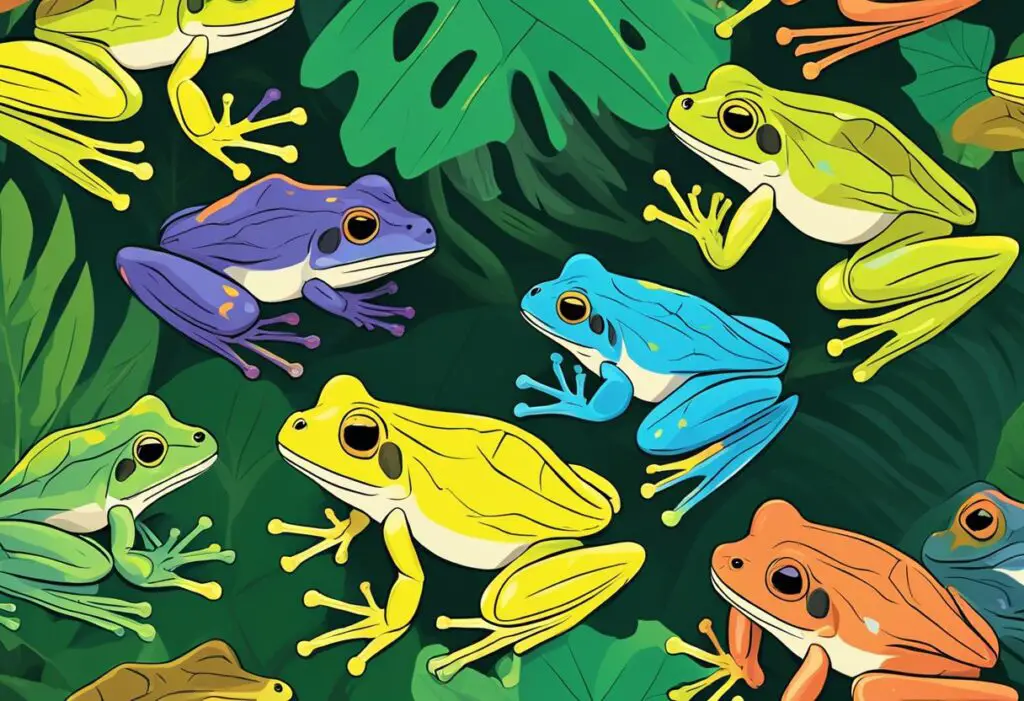
South and Central America
South and Central America are home to a wide variety of poisonous frogs. Brazil, Ecuador, Costa Rica, Nicaragua, Panama, and Venezuela are some of the countries where you can find these frogs. In fact, the Amazon rainforest is home to many species of poisonous frogs.
One of the most well-known species of poisonous frogs is the poison dart frog. These frogs are native to Central and South America and are known for their bright colors and toxic skin secretions. Other species of poisonous frogs in this region include the harlequin toad, the waxy monkey tree frog, and the green and black poison frog.
Other Continents
Although most species of poisonous frogs are found in South and Central America, there are some species that can be found on other continents as well. For example, Hawaii is home to the coqui frog, which is known for its loud chirping call. Australia is home to the giant barred frog, which is one of the largest species of frogs in the world.
Madagascar is home to the golden mantella, which is a small, brightly colored frog that is toxic to predators. In Africa, there are several species of poisonous frogs, including the African bullfrog and the painted reed frog. In North America, there are a few species of poisonous frogs, including the Pacific tree frog and the Colorado River toad.
Overall, the geographic distribution of poisonous frogs is quite diverse. Whether you are in South America, Central America, or another part of the world, there is a good chance that you will come across one of these fascinating creatures.
Safety Precautions
When it comes to handling frogs, it is important to take some safety precautions to avoid any harm. In this section, we will discuss some safety measures that you should take when dealing with frogs, especially poisonous ones.
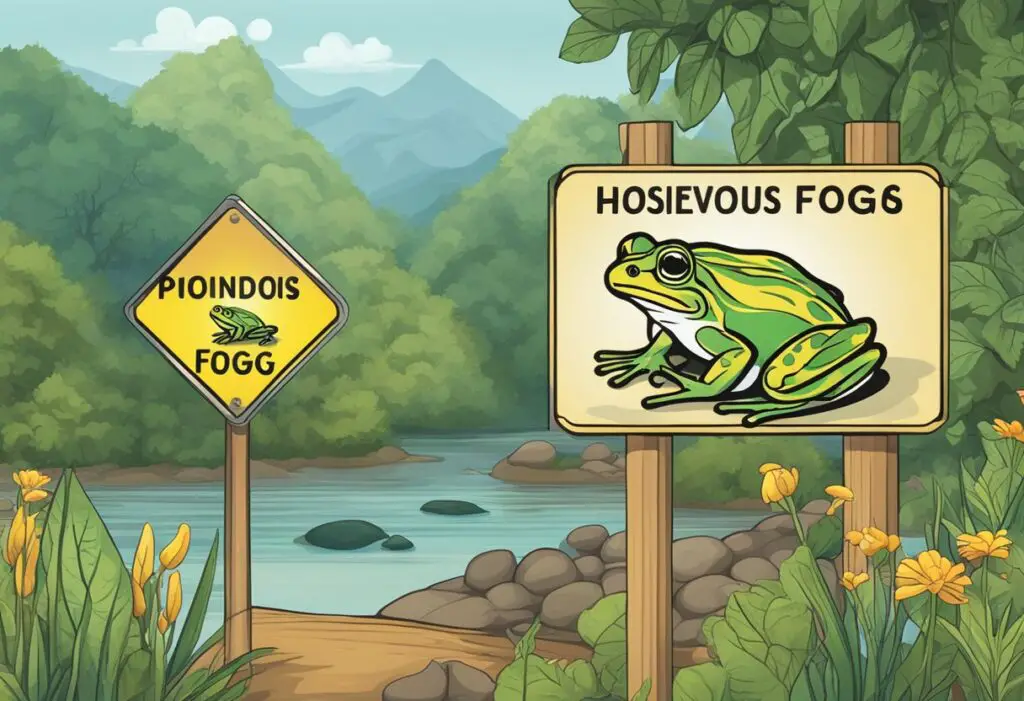
Handling Frogs
If you need to handle a frog, it is important to wear gloves to protect your skin from any toxins that may be present on the frog’s skin. Avoid touching your face or mouth while handling a frog, as this can lead to irritation or swelling.
It is also important to handle frogs gently and avoid squeezing them, as this can cause them to release their toxins. If you are not sure whether a frog is poisonous or not, it is best to avoid handling it altogether.
Pets and Poisonous Frogs
If you have pets such as dogs or cats, it is important to keep them away from poisonous frogs. Some frogs have toxic secretions that can be fatal to pets if ingested.
If you have a pet that has come into contact with a poisonous frog, look out for symptoms such as vomiting, nausea, and difficulty breathing. If you notice any of these symptoms, seek veterinary attention immediately.
It is also important to be aware of the types of frogs that are poisonous and avoid keeping them as pets. If you do keep poisonous frogs as pets, make sure to take extra precautions to ensure that they do not come into contact with humans or other animals.
Conservation and Environmental Impact
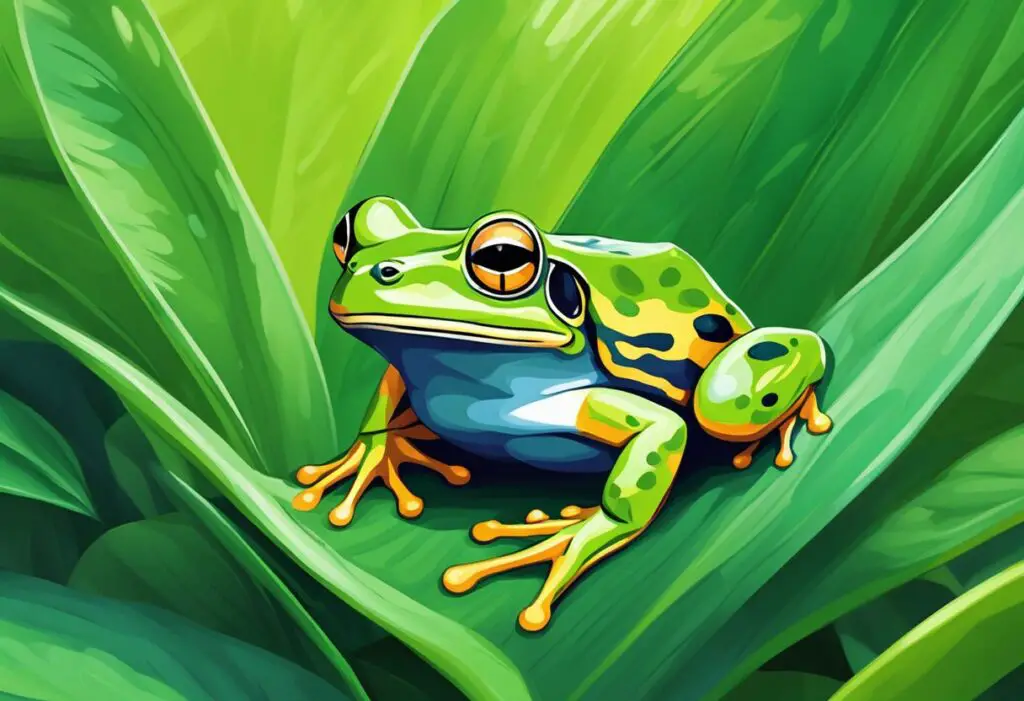
Threats to Frog Populations
Poisonous frogs are an important part of the ecosystem, and their disappearance could have significant consequences. Unfortunately, many species of frogs are currently under threat due to various environmental factors such as deforestation, climate change, and invasive species.
Deforestation is one of the most significant threats to frog populations. As rainforests are destroyed, the natural habitats of these frogs are lost, and they are forced to relocate or die. Climate change is also a significant factor, as rising temperatures can cause changes in the environment that make it difficult for frogs to survive.
Invasive species are another threat to frog populations. These non-native species can outcompete native species for resources, leading to a decline in frog populations. Additionally, invasive species can introduce diseases that native species are not immune to, leading to widespread deaths.
Conservation Efforts
Conservation efforts are critical to protecting frog populations. Many organizations are working to protect the natural habitats of these frogs and reduce the impact of environmental factors such as deforestation and climate change.
One of the most effective ways to protect frog populations is to protect their natural habitats. This means working to prevent deforestation and other activities that destroy rainforests and other natural habitats. Additionally, conservation efforts can focus on reducing the impact of climate change by reducing greenhouse gas emissions and promoting sustainable practices.
Another critical conservation effort is the protection of endangered species. Many species of frogs are currently endangered, and conservation efforts can help to protect these species from extinction. This can include efforts to reduce the impact of invasive species and promote the breeding and release of endangered frogs into the wild.
Frogs in Research and Medicine
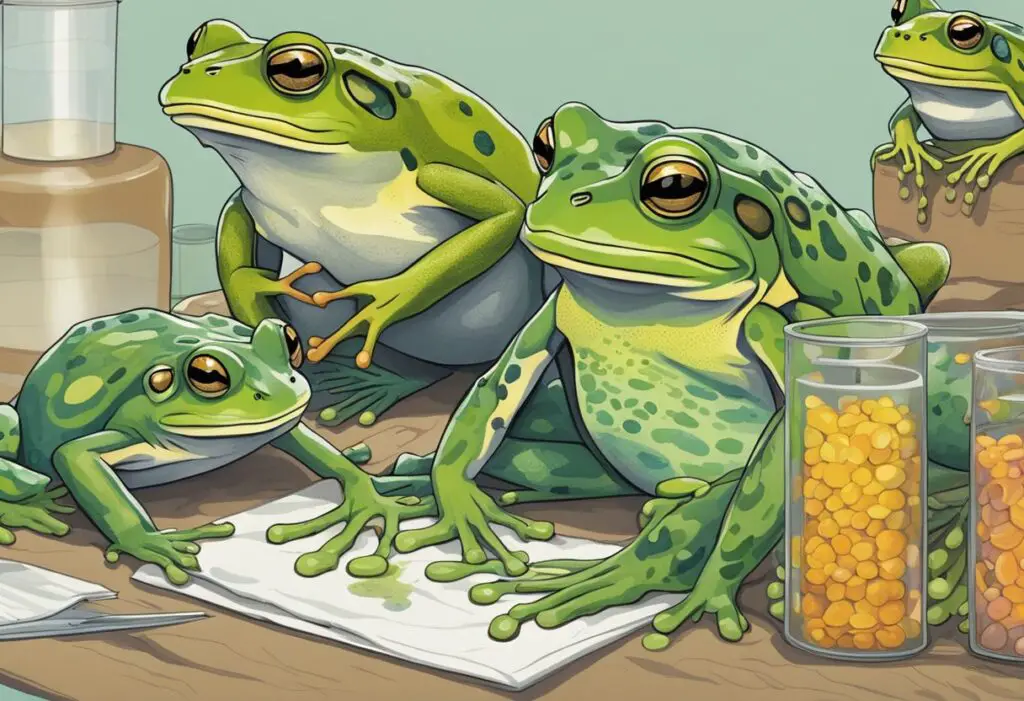
Frogs have been used in medical research for decades. Scientists have discovered that the alkaloid toxin produced by some species of frogs can be used to create muscle relaxants. These muscle relaxants have been used in a variety of medical procedures, ranging from minor surgeries to major operations.
One of the most significant uses of frog toxins in medicine is in the treatment of chronic pain. Researchers have found that certain types of frog toxins can block the transmission of pain signals to the brain, providing relief to those who suffer from chronic pain.
Another area where frogs have been used in research is in the development of new drugs. Researchers have discovered that the skin of some species of frogs contains compounds that can be used to create new pharmaceuticals. These compounds have been used to develop drugs that treat a wide range of medical conditions, from cancer to heart disease.
In addition to their use in medical research, frogs are also used in other areas of science. For example, scientists use frogs to study genetics and developmental biology. Frogs are particularly useful for these types of studies because they are easy to breed and have a short generation time.
Frog-Related Myths and Misconceptions
When it comes to frogs, there are many myths and misconceptions that people believe. These myths can be harmful and lead to incorrect assumptions about frogs and other amphibians. In this section, we will discuss some of the most common myths and misconceptions about frogs and provide accurate information to help you better understand these fascinating creatures.
Myth: All Frogs Are Poisonous
One of the most common myths about frogs is that all of them are poisonous. While it is true that some species of frogs are poisonous, not all of them are. In fact, only a small percentage of frogs are actually poisonous. These include the poison dart frog, the golden poison frog, and the blue poison dart frog.
Myth: Toads Are Always Poisonous
Another common myth is that all toads are poisonous. While it is true that some species of toads are poisonous, not all of them are. The American toad, for example, is not poisonous. However, it is important to note that some species of toads do have glands that secrete toxins, so it is best to avoid handling them.
Myth: Salamanders Are Poisonous
Many people believe that salamanders are poisonous, but this is not true. While some species of salamanders do secrete toxins, they are not typically harmful to humans. In fact, salamanders are often kept as pets and are not considered dangerous.
Myth: You Can Tell If a Frog Is Poisonous By Its Color
The color of a frog is not a reliable indicator of whether or not it is poisonous. While some poisonous frogs are brightly colored, others are not. Similarly, some non-poisonous frogs are brightly colored, while others are not. The best way to determine if a frog is poisonous is to consult a field guide or other reliable source of information.
Frequently Asked Questions
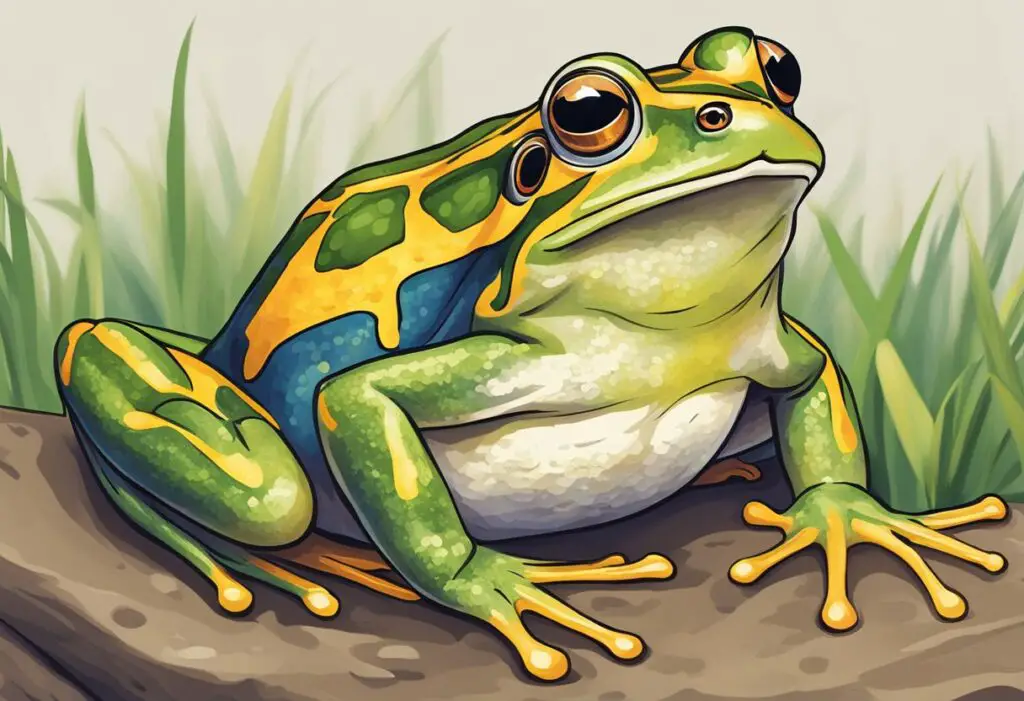
What are the typical colors or patterns to look for that might indicate a frog is poisonous?
Identifying whether a frog is poisonous or not based on its appearance can be difficult. However, many poisonous frogs exhibit bright colors and unusual patterns as a warning to potential predators. Some of the colors and patterns to look out for include bright red, yellow, orange, blue, and green. Poisonous frogs may also have spots, stripes, or other unusual markings.
Can touching a frog result in poisoning, and what should I do if it happens?
It is possible to experience poisoning from touching a frog. Some frogs have toxins on their skin that can cause skin irritation or even more serious symptoms if they come into contact with your eyes, nose, or mouth. If you touch a frog, it’s important to wash your hands thoroughly with soap and water. If you experience any symptoms such as itching, swelling, or rash, seek medical attention immediately.
What symptoms should a person expect if they’ve experienced frog poisoning?
The symptoms of frog poisoning can vary depending on the species of frog and the amount of toxin that was ingested. Some common symptoms include nausea, vomiting, diarrhea, dizziness, and difficulty breathing. In severe cases, frog poisoning can lead to convulsions, paralysis, or even death. If you suspect that you have been poisoned by a frog, seek medical attention immediately.
In what ways can identifying non-poisonous frogs be crucial for safety?
Identifying non-poisonous frogs can be important for safety because it can help you avoid accidentally ingesting toxins or experiencing skin irritation. Non-poisonous frogs can also be beneficial to the environment by controlling insect populations and serving as a food source for other animals.
What specific species of frogs in Florida should be avoided due to their toxicity?
In Florida, the most toxic frog species are the cane toad and the green tree frog. The cane toad, also known as the Bufo toad, secretes a toxin that can cause seizures, heart failure, and even death in pets and humans. The green tree frog, on the other hand, secretes a mild toxin that can cause skin irritation and other symptoms if ingested.
Are there any risks associated with consuming frogs, and how can one identify if a frog is safe to eat?
Consuming frogs can be risky because some species of frogs are poisonous, and toxins can accumulate in their bodies if they eat insects or other animals that are contaminated with toxins. If you plan on eating frogs, it’s important to identify the species and ensure that they are safe to eat. In general, frogs that are raised for consumption are safe to eat, but it’s important to avoid wild-caught frogs unless you are certain that they are non-poisonous.

